Before I begin, our family lost a brother over the weekend (14 September). Travis was taken from us too soon, but he left doing what he loved most, riding his Harley on a beautiful early autumn afternoon. To meet him was to know him, and to know him was to love him. You will be greatly missed, brother. On to today's post...
The cooling system for Hapy's new engine has been a journey. Looking back on multiple years of efforts to get Hapy to be genuinely water-cooled, today's post covers what may be the last thing I needed to do. I have lots of links referencing pretty much all of the things I've done, but I probably missed a few at the beginning of the project because many of those early posts covered multiple project aspects.
Initial Cooling System
Recall when I started this project, I sourced a radiator off craigslist for $30 (See
TDI - Day 2). At the time, I was even offered the air-conditioning condenser, and it had the original fans. I passed on the air-conditioning condenser, which he subsequently sold, and I removed the fans. I added 2 flex-cool fans and wrapped the radiator with an aluminum frame (See
bracketing the radiator and
rad brackets continue) and put sides on it (See
Radiator shrouded) to reduce the amount of air allowed to slip back around from the rad exhaust back into the rad intake. This sort of worked, though I always had my eye on the temperature. Along the way, I removed a bunch of extra wiring from the original harness that was part of the air conditioning circuit, and added a switch to the dash for turning the fans on.
Troubles

Then the leaks started. I spent many hours trying to solve outlet flange leaks (See
Reality Strikes, for example). Ultimately, I learned that the plastic parts were designed to fail first, so more expensive parts didn't fail when the engine got too hot and the coolant expanded faster than the expansion tank could handle. Still, replacing that outlet flange and getting the coolant temperature sensor to seat properly are two of the most patience-testing things I've done on this conversion. Having these components by the fuel tank makes the reach and visibility particularly difficult.
Still, with the system seemingly in-tact, the engine temperature would still climb and not come back down easily. As the miles and years passed, the engine would heat up faster and cool down slower. We had a super-long return from 4Peaks in 2017 (See
4Peaks 2017 - Road Report), and had our first vagabonding experience when we were unable to make it to Frog Lake due to an overheat, and big coolant loss (See
Almost Frog Lake Part 1 and
Part 2). The whole time, Boo was incredibly supportive, and heroically kept my spirits up. My last, most tragic failure was when I added the wrong kind of coolant. That amplified the problems, and ultimately led to the troubled drive to Newberry this Summer (See
Newberry 2019 - Getting There).
Resolution Path
I promised Hapy that I would start fixing the cooling system when we were on the side of the US-26 outside Rhododendron, unable to make it to Frog Lake. So, that next Spring, I replaced the old Jetta radiator with a Mishimoto all-aluminum radiator (See
Back to the Bus: Rad Swap Part 1 and
Part 2). Things were not that much better on the way to 4Peaks in 2018 (See
4Peaks 2018 - Road Report), but with the ignition fire on the way home, it quickly moved to the back burner. I removed the wiring for the heater fan controls when I did the ignition replacement, believing it was causing large load spikes. While that didn't really change the cooling system, its a change worth documenting. By the time the ignition was done, festival season was over. But before I covered Hapy for the winter, I replacing the fans with a real dual-fan shroud (See
Cowling the Hapy Radiator). I thought this was the final solve. The drive to 4Peaks seemed fairly good (See
4Peaks 2019 - Road Report), with temperature spiking at 196*, but the drive home was again spent watching the temperature gauge. We peaked at 205*, but the alternate route through the farm country allowed us to keep our speed (and therefore temperatures) down. The drive to Newberry, though, was enough for me to know that I had not solved the problem, and I really needed to fix it right if I was going to truly enjoy driving distances with Hapy.
Last Solve
In my last post, I described the issues with the fuel I bought in Oakridge (See
Green Diesel isn't BioDiesel). That bad fuel held my speed so low, I didn't
have temperature issues the rest of the way home. I knew they still lurked, so after the fuel system was drained, new filter system installed and new fuel added, I shifted back to my nemesis: the cooling system. I started with a basic drain and water-flush. Then, I removed the thermostat and filled with water, ran the engine, and drained. I did this a couple of times. Then, I went nuclear and did a chemical flush with
Thoroflush. The Prestone radiator flush is weak tea compared to this stuff.
The directions are hard to find on the internet, but it's fairly clear:
Remove 1 gallon of coolant from your system
Mix one gallon of water with the right amount of Thoroflush mix for your application
Add mixture to cooling system
Get engine up to temperature (to open thermostat) and run for 10-15 minutes. DO NOT RUN LONGER THAN 15 MINUTES
Drain and flush with water until drainage is clear (no pink from chemicals)
Seems fairly straightforward. But, I pulled my thermostat, so how long do
I need to run it? I was unable to find any direction for this case. I concluded that since my engine was fairly warm (upper 160's), if I added the mixture and ran it for less than 15 minutes, I would do no harm, but might not get maximum benefits. So, that's what I did. I used the water from the 2nd rinse-flush and added the mixture to that, ran the engine for just shy of 15 minutes, drained, flushed, and flushed again. After flushing everything out, I re-installed the thermostat with a new housing and O-ring. I determined that the old housing was slightly warped (possibly from the flushing efforts), and found that removing the hose from the thermostat housing makes re-install 100x easier. I filled with G40 and distilled water, clearing the bleeders so there were no air pockets trapped in the system.
Testing and Proving
 |
| gmap image of 99W steep |
I wanted to demonstrate that
this was the fix. So, I drove around town like a total dick: jack-rabbit starts, rapid accelerations... basically zooming around West Beaverton pushing the bus as hard as I could for a good 15 or 20 minutes. It wasn't until I pulled over onto our quiet street that the temperature raised above 185*F (to 188*F), and even then it was only for a second before it dropped back down to 185*F. The real test came later in the week when we drove to Honeyman State Park, up to Newport, through Lincoln City and home again. I'll post on that trip later, but I'll summarize the coolant test with a simple number: 194. 194*F was the highest the temperature ever got the entire 300+ mile road trip, including climbing the coast range and driving in slow, heavy traffic. At no time did I need to pull over because of the temperature. I did not drive especially gingerly either.
There is a hill climb on 99W between Newberg and Sherwood. Every time we take the back road alternate route, we drive up this hill as our last big pull. Accordingly, it is a consistent gauge for how Hapy is doing. When I drove this hill after Newberry, I barely kept the temperature under 203*F, driving with the flashers on in 2nd gear (25mph* tops). This time, Hapy's temp peaked at 194*F running at the speed of traffic (55mph*) in 4th. In both cases, this was at the end of a multi-hour daytime summer-heat drive. This feels like strong evidence the cooling issues have been solved.
That's it for today's saga. Sorry there weren't any real pictures, there really wasn't much to take a picture of, except, maybe, a picture of the cooling system map. That reminds me, I never did document system-by-system how the conversion was done. Hmm.. maybe I should dust off that documentation effort over the winter. Anyway, thanks, as always, for following along.
 That's a great question. The head unit is resting on top of the cardboard that it shipped in. That's the most expensive part of this operation, and it isn't held down at all. Well, I drove to Newberry (La Pine Oregon) and back, as well as a 300 mile round trip from home through Eugene, Florence, Newport and Lincoln City before circling back home again (yes, there are posts on that trip coming). That's over 600 miles all together and the head unit didn't bounce at all. The slap-together wiring of the rear speakers, however, came apart plenty. So, that needs to be first.
That's a great question. The head unit is resting on top of the cardboard that it shipped in. That's the most expensive part of this operation, and it isn't held down at all. Well, I drove to Newberry (La Pine Oregon) and back, as well as a 300 mile round trip from home through Eugene, Florence, Newport and Lincoln City before circling back home again (yes, there are posts on that trip coming). That's over 600 miles all together and the head unit didn't bounce at all. The slap-together wiring of the rear speakers, however, came apart plenty. So, that needs to be first. I took the speaker wires I had flopping around, and routed them behind that side panel. Just past the mid-point of the fridge/storage cabinet, I spliced in a pigtail, and more speaker cable. The pigtail is just like the pigtails I put into Oliver's (the '78 MGB) trunk. I had corresponding pigtails added to short runs of speaker cable that ran into the speaker boxes. I extended speaker cables (for both left and right) behind the rock-n-roll bed to the far passenger side, terminating with another set of pigtails. This created a means of plugging in speakers either at the fridge/storage cabinet or at the slider.
I took the speaker wires I had flopping around, and routed them behind that side panel. Just past the mid-point of the fridge/storage cabinet, I spliced in a pigtail, and more speaker cable. The pigtail is just like the pigtails I put into Oliver's (the '78 MGB) trunk. I had corresponding pigtails added to short runs of speaker cable that ran into the speaker boxes. I extended speaker cables (for both left and right) behind the rock-n-roll bed to the far passenger side, terminating with another set of pigtails. This created a means of plugging in speakers either at the fridge/storage cabinet or at the slider.







